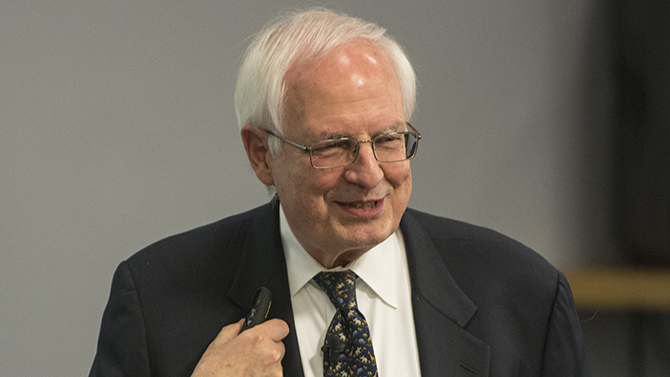


Curing health care with data
Photo by Doug Baker May 05, 2017
A. Blanton Godfrey discusses innovation and its role in health services
Zika, a mosquito-spread virus that causes birth defects in the fetuses of infected mothers, has created a panic in recent years, and caused serious damage across the globe. But thanks to the work of A. Blanton Godfrey, innovations in maternity clothing may soon reduce the risk of the virus for pregnant women.
Godfrey, an applied statistician who has been the head of the Quality Theory and Technology Department at AT&T Bell Labs, the chairman and CEO of Juran Institute Inc., the dean of the College of Textiles and Joseph D. Moore Distinguished University Professor at North Carolina State University, discussed his work as part of the University of Delaware’s sixth annual W.L. Gore Lecture Series in Management Science.
With a background in engineering and textiles, Godfrey is part of the lab utilizing the North Carolina State University’s College of Textiles to create innovative health solutions. And the mosquito-bite-resistant clothing isn’t Godfrey’s only step toward innovating in the field of health services.
Godfrey co-founded the National Demonstration Project for Health Care Quality Improvement, a nonprofit focused on improving the current health care system. Godfrey’s publication, Curing Health Care, has the goal of creating 100 million healthier lives. The book talks about his research in reducing costs while improving care.
“We’ve invested $700,000, and we’ve saved over $3 million,” Godfrey said of his work in health services. “This is the kind of data analysis we really need.”
As a statistician, a member of academia and an expert in medical innovation, Godfrey had a lot to share with the lecture audience.
Godfrey began his speech with his description of innovation:
• A breakthrough in science or technology.
• Reduction to practice.
• Ability to produce product or service at affordable cost and price.
• Widespread acceptance by the marketplace.
He discussed how over 2.9 sextillion transistors — semiconductor devices with applications in amplification, like transistor radios — have been created since the technology was invented. However, Godfrey said, real innovation comes when people start thinking about how to use technology in new ways that improve the world around them.
“When we think about how we put these pieces together to make something different, that’s impact,” Godfrey said.
Godfrey said the average time between when something innovative is published to when it is actually used is 17 years. He gave the example of incubators, explaining that the doctor who discovered their use with premature babies could not find a hospital to support him, so the doctor spent years funding his work by setting up incubators with premature babies on the Coney Island boardwalk and charging people to see them as entertainment.
“When we create research, we pray that someone will use it,” Godfrey said. “We pray that someone will cite it. We pray that we will get published, and that we will be rewarded with tenure. But do we have any clue whether we’ve made an impact?”
The way to know an impact was made? According to Godfrey, the best way to know there was an impact is to see the change for yourself, and to teach innovation to students who will make impacts in the future.
About the Gore Lecture
The Gore Lecture, presented by UD’s Alfred Lerner College of Business and Economics, is sponsored by an endowment from the Gore family.
This lecture series features experts in the application of probability, statistics and experimental design to decision-making, including applications in academia, business, government, engineering and medicine.
The series recognizes the key role that the fields of probability, statistics, and experimental design have played in the success of W.L. Gore and Associates Inc.
Contact Us
Have a UDaily story idea?
Contact us at ocm@udel.edu
Members of the press
Contact us at 302-831-NEWS or visit the Media Relations website

